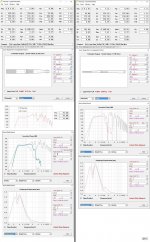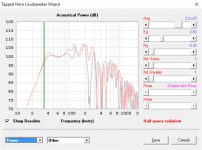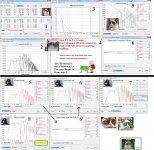You can try fiddling around with the sliders and change all aspects of the horn to see if you can get that spike smaller or at least narrower (the narrower it is the less it will show up in a measurement, as most of it gets eaten up by box losses in the real world if it's really narrow).
There's two other options that will definitely work though. The first option is stuffing. That will eat that spike right up, and Hornresp can sim stuffing. In one of the first tapped horns I made I put very light fiberglass stuffing in the first few feet and that spike is completely missing in the measurement - it would be nice if I could remove some of the stuffing as I now have a dip instead of a spike but it's inaccessible. Stuffing is a net loss though, so avoid it if possible.
The other option is to make the horn larger. As the horn gets exponentially larger (and still tuned at the same frequency) the spike will stay ~ the same size but the spl response over the entire passband will rise up to the level of the spike. This is a great way to go if you don't mind a massive box.
Other than that it's just playing with the sliders and seeing what happens.
There's two other options that will definitely work though. The first option is stuffing. That will eat that spike right up, and Hornresp can sim stuffing. In one of the first tapped horns I made I put very light fiberglass stuffing in the first few feet and that spike is completely missing in the measurement - it would be nice if I could remove some of the stuffing as I now have a dip instead of a spike but it's inaccessible. Stuffing is a net loss though, so avoid it if possible.
The other option is to make the horn larger. As the horn gets exponentially larger (and still tuned at the same frequency) the spike will stay ~ the same size but the spl response over the entire passband will rise up to the level of the spike. This is a great way to go if you don't mind a massive box.
Other than that it's just playing with the sliders and seeing what happens.
As previously pointed out, it's much lower in reality and considering the number of folks who've successfully used/EQ'd THs, just not much of an issue in reality; but if you must, then do like Tom did with his first [and only] TH and use band stop filters [Helmholtz resonators made from plastic pipe in this app] to 'hammer' them down: https://www.google.com/search?q=dts...hWE4yYKHV6HDmoQ_AUIBygC#imgrc=9y2Uautj0VZYcM:
Note too, that selective damping in the right places helps to smooth out this out of BW, HF 'hash', which FWIW is the only actual horn loaded BW.
Bottom line, this is a ~two octave 6th order BP, so the XO should ideally be < ~131 Hz and preferably at least 4th order.
GM
Note too, that selective damping in the right places helps to smooth out this out of BW, HF 'hash', which FWIW is the only actual horn loaded BW.
Bottom line, this is a ~two octave 6th order BP, so the XO should ideally be < ~131 Hz and preferably at least 4th order.
GM
As previously pointed out, it's much lower in reality
That actually hasn't been the case for the last three POCs that I built, when I compared their measured FR to the HornResp sim. Lower, yes. Much lower? No.
I think TD found other means to reduce the out of band spikes, so he no longer needed to use the tube resonators.
Best approach IMO is to go with a design that ensures that the first major spike occurs about an octave or so above where you plan to LP the TH, and then deal with it using the methods previously discussed. Partly stuffing the TH and modifying the alignment accordingly would probably be my first choice. Or maybe convert some of the volume @ S1 in a SS15 fold to be a resonating chamber tuned to the first spike's frequency...
The spike is only much lower in real life if it's narrow. If it's relatively wide it maintains most of it's amplitude.
IIRC the DTS20 also used a 4mh series inductor and stuffing (lining) so even his big pipe filters were not completely effective.
Ivan Beaver says the inductor is doing exactly the opposite of what you would expect it to, but I seriously doubt it, the effect of inductors is no big mystery. Danley DTS20
IIRC the DTS20 also used a 4mh series inductor and stuffing (lining) so even his big pipe filters were not completely effective.
Ivan Beaver says the inductor is doing exactly the opposite of what you would expect it to, but I seriously doubt it, the effect of inductors is no big mystery. Danley DTS20
That actually hasn't been the case for the last three POCs that I built, when I compared their measured FR to the HornResp sim. Lower, yes. Much lower? No.
Yes, yours weren't reduced much, but then IIRC they weren't very well designed either if my understanding of how to design them is near enough as good as TD's. Regardless, there's been quite a few builds published here and on other forums that were pretty well damped before internal damping, DSP corrected was applied.
Bottom line of course is build it and see or do something else, but 'throwing away' this much BW? Better to just build BRs.
GM
The spike is only much lower in real life if it's narrow. If it's relatively wide it maintains most of it's amplitude.
Well, I obviously don't consider mine relatively wide, but if one wants a simmed narrow spike, then a DTS [attached] with its lower mandated tuning is larger with a much lower power handling capability and a bit more complex layout, woodworking or instead build a TTQWT or BR.
GM
Attachments
Yes, yours weren't reduced much, but then IIRC they weren't very well designed either if my understanding of how to design them is near enough as good as TD's.
Really? Explain. I'm curious as to why you'd believe that they weren't "very well designed", and how such design impacts the out of band response peaks.
As TD has noted many times both here and on other forums, Prof. Leach's math is the 'real deal' for compression horn design, ergo it would be no different for THs, so what I use and since I have no trouble 'lining up' his designs in sims using his math and 'satisfactorily explaining to myself' some things that historically have left some others 'scratching their heads' as to why they can't seem to match DSL's performance with the same driver in a similar net bulk.........
Yours, and many others for that matter, OTOH seem to have little/no underlying acoustic theory behind them except those that used Eazy Horn, i.e. the alignment isn't matched to the driver's [effective] specs, measured or not.
HR, AkAbak [maybe others] obviously will sim very close to 'as built' when properly done, so just as obviously there's about as many ways to design these alignments along a ~continuous curve same as a sealed or vented alignment, but we all know that some perform better than the others, especially at higher power, which these programs can't accurately sim.
GM
Yours, and many others for that matter, OTOH seem to have little/no underlying acoustic theory behind them except those that used Eazy Horn, i.e. the alignment isn't matched to the driver's [effective] specs, measured or not.
HR, AkAbak [maybe others] obviously will sim very close to 'as built' when properly done, so just as obviously there's about as many ways to design these alignments along a ~continuous curve same as a sealed or vented alignment, but we all know that some perform better than the others, especially at higher power, which these programs can't accurately sim.
GM
HR, AkAbak [maybe others] obviously will sim very close to 'as built' when properly done, so just as obviously there's about as many ways to design these alignments along a ~continuous curve same as a sealed or vented alignment, but we all know that some perform better than the others, especially at higher power, which these programs can't accurately sim.
That is the key point there. The equations and "Eazy Horn" will provide some alignment suggestions, but that does not mean that those suggestions would be the best fit for the designer's requirements wrt to issues like target F3, box size, folding requirements, etc.
e.g. EZ Horn suggests something like a 237L minimum enclosure for the 12" PA310 with its 5mm Xmax to get to 40 Hz. Obviously no-one is going to be inclined to build something that huge for that driver that size with that low an Xmax. I was able to get to 40 Hz with it in 104 L with it in POC2, by compromising on efficiency and some of the upper passband response. The other designs had other requirements that led me to choose their specific design parameters.
However, none of this really answers the 2nd question I posed concerning the out of band noise spikes, unless you're suggesting that if the THs are designed according to Leach's equations, the out of band spikes become a non-issue, in which case would you describe the design you provided for the poster's driver a "well-designed" one?
GM[/QUOTE]
Hmm, guess I need to revisit Eazy Horn as I don't remember it setting a minimum net Vb.
Regardless, the driver's specs dictates its optimum F3, etc., so if the 'shoe doesn't fit'....... 'shoehorning' it in obviously will work, just as one can walk in shoes too large or too small, just not optimally, which is my main point.
No, not suggesting that at all, just that when optimally designed, when the 'shoe fits', the alignment's acoustic damping will reduce them more than when misaligned, especially once the average/peak power used is factored in.
Note too that I've never posted a truly optimized alignment for hopefully obvious reasons, just ones that gets all the basics right WRT the available specs, though the DTS ones are closer than the prosound alignments, hence the ones I prefer for HIFI/HT apps; and like Tom, prefer to use a second driver to offset the lower power handling.
GM
Regardless, the driver's specs dictates its optimum F3, etc., so if the 'shoe doesn't fit'....... 'shoehorning' it in obviously will work, just as one can walk in shoes too large or too small, just not optimally, which is my main point.
No, not suggesting that at all, just that when optimally designed, when the 'shoe fits', the alignment's acoustic damping will reduce them more than when misaligned, especially once the average/peak power used is factored in.
Note too that I've never posted a truly optimized alignment for hopefully obvious reasons, just ones that gets all the basics right WRT the available specs, though the DTS ones are closer than the prosound alignments, hence the ones I prefer for HIFI/HT apps; and like Tom, prefer to use a second driver to offset the lower power handling.
GM
Hi All,
FYI:
b
This really looks good, but for some reason I can't reproduce your results in my sim; did everything you've done and here's what it looks like:

That looks weird to me; I don't think it is supposed to be there.. What am I missing?
You can try fiddling around with the sliders and change all aspects of the horn to see if you can get that spike smaller or at least narrower (the narrower it is the less it will show up in a measurement, as most of it gets eaten up by box losses in the real world if it's really narrow).
There's two other options that will definitely work though. The first option is stuffing. That will eat that spike right up, and Hornresp can sim stuffing. In one of the first tapped horns I made I put very light fiberglass stuffing in the first few feet and that spike is completely missing in the measurement - it would be nice if I could remove some of the stuffing as I now have a dip instead of a spike but it's inaccessible. Stuffing is a net loss though, so avoid it if possible.
The other option is to make the horn larger. As the horn gets exponentially larger (and still tuned at the same frequency) the spike will stay ~ the same size but the spl response over the entire passband will rise up to the level of the spike. This is a great way to go if you don't mind a massive box.
Other than that it's just playing with the sliders and seeing what happens.
I think the combination of line level high pass filter and the amp's low-pass XO as well as some stuffing will do it. That's what I ultimately plan to use, at least for now.
Hmm, guess I need to revisit Eazy Horn as I don't remember it setting a minimum net Vb.
It doesn't, but it doesn't take too long to plug the driver's parameters into Eazy Horn, set a target F3, run through a few options with it and notice a trend.
The PA310 driver continues to work just fine in my POC3 box, unaware that its "shoes" are too small
Here's a comparison between the alignment I came up with for POC4, designed for a 33Hz~100Hz bandwidth requirement , and one suggested by EZ Horn with a near identical lower resonance frequency. The EZ Horn alignment is about 140L larger. Is that extra 140L worth it?
Attachments
This really looks good, but for some reason I can't reproduce your results in my sim; did everything you've done and here's what it looks like:
An externally hosted image should be here but it was not working when we last tested it.
That looks weird to me; I don't think it is supposed to be there.. What am I missing?
Hi vrfood,
Grumpy Cat findings
As usual here at diyAudio: A posted(TH) SQ disaster again:
IMO: All Quarter Wave TH HR plots should incorporate the use of Damping Materials
b
Attachments
Hi vrfood,
Grumpy Cat findings
As usual here at diyAudio: A posted(TH) SQ disaster again:
IMO: All Quarter Wave TH HR plots should incorporate the use of Damping Materialsif ever sent to 'Subwoofers', especially if in real life folded more than once.
b
I like how you used the memes, LOL
vrfood;4613414.. can you please post the picture with better resolution? I can not see anything...[/QUOTE said:Not needed: Just click on the expansion Cross at the lower left Corner of the Picture.
b
Not needed: Just click on the expansion Cross at the lower left Corner of the Picture.
b
Thanks. That worked
- Status
- This old topic is closed. If you want to reopen this topic, contact a moderator using the "Report Post" button.
- Home
- Loudspeakers
- Subwoofers
- 1 driver tapped horn / hornresp

 Saved me the trouble.
Saved me the trouble. 
